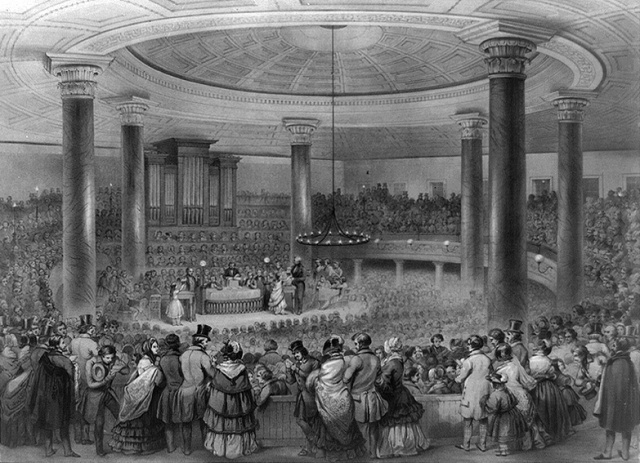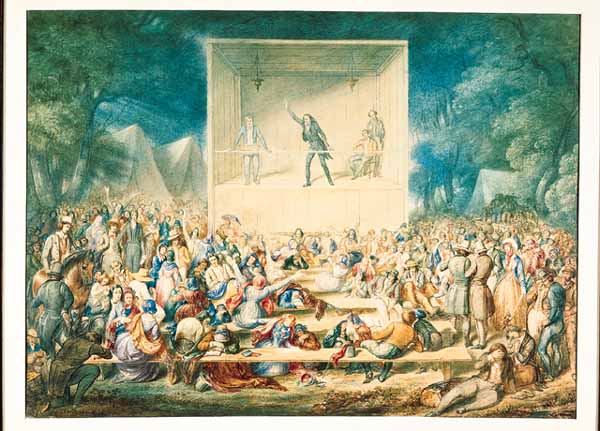Evangelicalism in the United States, and Christianity in the United States in general, has many problems. One only need to compare what is acceptable in Evangelical culture to the teachings of Jesus to see some of the more obvious conflicts. These problems go beyond the failings of individual leaders or the simple fact that human frailty constrains our ability to live out our espoused ideals. To me, Evangelicalism is empty; it is an easily distracted civil religion, led by charismatic leaders who may or may not follow Jesus’ teachings, that is easily co-opted by other agendas and ideologies. I would argue that a lot of these problems stem from structural, theological and systemic issues at the foundation of Evangelicalism, some of which started during the Second Great Awakening. To explore this issue a bit more, after briefly introducing what the Second Great Awakening was, I want to focus on three problems within Evangelicalism that have come from this time: a focus on theatrics and technique, a focus on charisma, and the proliferation of a shallow Gospel.
What was the Second Great Awakening?
The Second Great Awakening was a second Christian religious revival in the United States that started in the late 18th century and continued into the early 19th century. This Second Great Awakening was actually a number of different revivals that unfolded in many different geographical areas, in many different denominations, but were nonetheless theologically and practically very similar. Revivalists in the cities and the frontiers hosted revival meetings that presented the Gospel to thousands of people at a time. Often these revivals events unfolded over the course of several days before moving onto the next area. During this time millions converted to Evangelical denominations causing a dramatic rise in their membership. Christianity in the U.S. still bears the impact of these movements. Today roughly one fifth of the U.S. identifies as a “born again,” evangelical Christian, direct theological and ideological descendants from this time.
While there are arguably some positive or progressive developments from this era, I want to turn to the three problems I think were initiated in this era and are still with Evangelicalism today.
A Focus on Theatrics and Technique
The revivals of the Second Great Awakening were as much theater as they were preaching or teaching. The revivalists of this time recognized the importance of presentation, technique and entertainment to their endeavors and quickly incorporated them into their revivals. Everywhere a revival went, a theater like stage (such as the one depicted in the drawing above) was present. Plays, lighting, music and other methods started being used to cultivate an environment ripe with emotionalism and excitement to foster conversions. This was perhaps especially effective in the frontier revivals, where the remote location meant any large gathering of people would bear the promise of excitement far beyond what the area normally saw.
This begs the question if the revivals were the work of the Spirit or the work of man and emotional manipulation. Even in their day some revivalists worried conversions were being manufactured through the methods revivalists were using, not through a true conversion brought on by a genuine response to hearing the Gospel. The revivalist Nettleton, in worrying over the agency of God in the Second Great Awakening wrote, “Should a revival be desired, the machinery would go into gear and it would be created through sheer willpower and method.”
The practice of using theatrics and technique to cultivate a specific response from the congregation never left Evangelicalism. It can be found at large mass rallies and contemporary revivals but also in your average Sunday service. Walk into any Protestant church in the United States and they will probably have a designated stage with at least a modest lighting and sound system. Some churches have spent hundreds of thousands of dollars on lighting and sound systems that rival local theaters and cinemas. This theatrical apparatus is used to foster an environment of entertainment and emotionalism, ripe for religious experience. It is any surprise some hold a consumer attitude towards church attendance, where they attend churches so long as that church can provide the spiritual experience they are looking to consume or enjoy?
A Focus on Charisma

The Brooklyn Tabernacle, created for Charles G. Finney, was either the first or the forerunner of the megachurch in the U.S.
The Second Great Awakening also rather quickly became centered around personalities. As the revivals unfolded a handful of specific revivalists became incredibly well known. Soon lecture halls and tents were erected specifically so that these famous revivalists could be heard and enthralled by as many people as possible, hopefully leading to a revival in the area. The creation of the Brooklyn Tabernacle (pictured above), built so that thousands of people could hear Charles G. Finney speak at one time, is one such example of this.
In the environment of the revivals it was charismatic leaders with strong voices, handsome faces, and winsome personalities who won the most converts, received the most attention, and gained the most sizable following. This led to a situation where personal charisma become the most prized trait in a Christian leader. Education, character, or knowledge of and allegiance to the teachings of Jesus, became afterthoughts to a leader’s ability to win and keep a cult-following through personality alone. For example while Nettleton expressed his worried that the revivals were not authentic and were being manufactured, Finney responded by basically saying, “Well it works.” History has shown that the unconcerned Finney is remembered by many while Nettleton is essentially forgotten.
This preference for charisma has never left Evangelicalism. In her piece The Line Between a Heretic and a Prophet is Thin, Suey Park, stated that “What I didn’t realize was how much white evangelical Christians would cherish this skill [the ability to perform and be liked]; the church often values charisma over character.” This Evangelical preference for charisma over character is not something new, and if anything it has heightened. Evangelicalism is today essentially captivate to super-apostles who write books, run mega churches, go on speaking circuits and launch movements, whose success is due more to their personality than any other aspect of their life or faith.
A Shallow Gospel, and Room for Other Ideologies
Most importantly the Second Great Awakening sparked the proliferation of a very shallow Gospel.
The revivalists employed an incredibly simple and short Gospel in their work. It went was something like this:
Humanity is sinful and deserves eternal punishment. To forgive us, God sent his only son Jesus to die for our sins. To get into Heaven and avoid going to Hell, a person has to pray to accept Jesus as their Lord and savior.
I call this Gospel the Evangecube Gospel, or the Heaven’s Gates Hell’s Flames Gospel after some more contemporary methods used to share this same Gospel. When combined with charismatic leaders using theatrics and techniques to stir up emotionalism, it was (and is) wildly successful at winning converts.
The problem is then that these newly minted followers of Jesus had a faith based on a dubious spiritual experience that was grounded in an understanding of the Gospel that is either woefully incomplete or an altogether false representation of the Gospel.
Even if accepted as the Gospel message, it must be admitted the Gospel of the revivalists is a very shallow or narrow Gospel that omits much of the scriptural story. This Gospel is devoid of any connection to or even mention of the history of Israel. This Gospel is devoid of any of Jesus’ teachings that He would have His followers embody and live out. This Gospel cannot be reconciled with the historical and cultural context within which it supposedly originated. While many verse-bites allegedly support this Gospel (*glares at John 3:16*), it cannot be reconciled with a broader reading of scripture. Ultimately this Gospel is about assuring a person of their individual salvation and not much else.
This shallow Gospel leaves a lot of room for other ideologies to creep into the lives of believers. This has produced a situation where people claim to be Christian followers of Jesus, and perhaps even identify their faith as the central aspect of their identity, who live their lives according to other ideologies, many of which conflict with the teachings of Jesus.
As history has progressed other ideologies have indeed taken root within American Evangelicalism, to the point where they eclipse the actual teachings of Jesus. Nationalism has crept in, allowing for followers of Jesus to violate Jesus’ teachings on non-violence without concern. Consumerism, capitalism and materialism has crept in, allowing for followers of Jesus to violate Jesus’ teachings on wealth. The pursuit of the American Dream has crept in, allowing followers of Jesus to pursue the well-being of their family while ignoring the plight of all others, despite Jesus’ teachings on justice and social welfare.
What does this all mean?
The Second Great Awakening set the evolutionary trajectory of Evangelical Christianity for decades to come, if only because of the sheer amount of people these revivals won to the Evangelical movement. A focus on theatrics and technique to craft an emotional/spiritual experience, the focus on charisma, and the proliferation of a shallow Gospel are three main aspects of Evangelical culture and theology that come from this era. Of these, the proliferation of the shallow Gospel is perhaps the most problematic. Because the Evangelical Gospel is so thin, it barely conflicts with other ideologies, so long as these other ideologies do not present an alternative pathway to personal salvation. This created room for other ideologies to creep in and even dominate Evangelical culture and theology, without anyone realizing how inappropriate these ideologies are for followers of Jesus. If this issue is to be addressed, the core definition of the Gospel in Evangelicalism must be addressed. Anything less will probably be as fruitful as polishing the brass on the Titanic.

